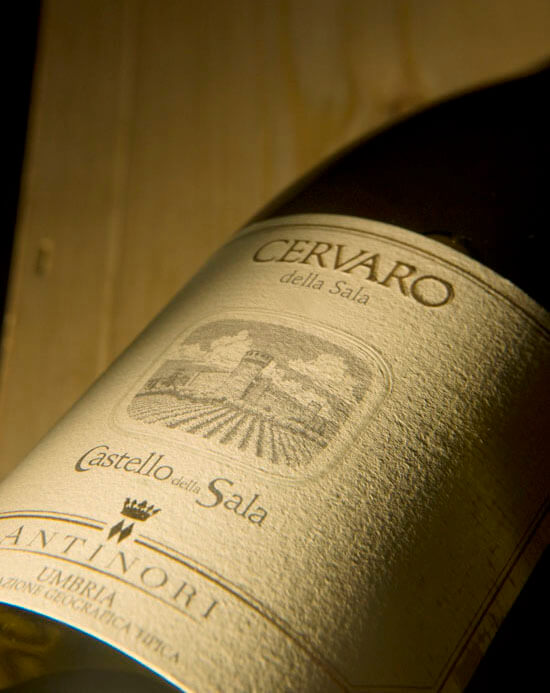by S. Irene Virbila
Longtime Director of Winemaking for Marchesi Antinori, Renzo Cotarella has a special affection for Cervaro della Sala, the finely woven Chardonnay-Grechetto blend from Castello della Sala in Umbria.
“To produce something from the area where I was born, for me, has been a great honor,” he explains to the group of sommeliers invited to the tasting. “This is a wine which I really love, particularly because it’s the first wine I made.”
In 1979, Cotarella was barely out of enology school when Marchese Piero Antinori, then quite young himself, tapped the Umbrian to run Castello della Sala, a sprawling property north of Orvieto that his father, Niccoló, had acquired just before the start of World War II.
Cotarella remembers Antinori showing him around the property and proposing, “Why don’t we try to make a white wine of quality here?”
Why not?
At the time, Central Italy was not exactly known for its white wines. Based on Trebbiano and Malvasia, Orvieto was typically a bit flat and tended to become oxidized after a few months. Cotarella hoped to do better. And Antinori gave him free rein to try something new.
He began by planting some non-local varietals, mainly Chardonnay, Pinot Blanc, Pinot Gris and Sauvignon. He also introduced selections of Grechetto, a grape already included in the blend of Orvieto. “My idea at the time was to improve Orvieto, not to make a different wine,” he explains.
A trip to Bordeaux in 1981 with erudite gastronome and Sacramento grocer Darrell Corti changed his mind. “The trip was a nightmare,” says Cotarella, “because he wanted to have lunch and dinner in two or three Michelin restaurants every day. It was just too much. Sometimes you just want to have some ham and cheese and a piece of bread.”
After four days of Bordeaux, Bordeaux, Bordeaux, he was exhausted. When the small group arrived in Nice on their way back to Italy, Corti proposed dinner at a fish restaurant. Nobody else wanted to come, and Cotarella, as the youngest, couldn’t say no.
Corti proceeded to open the wine list and choose a ’71 Corton-Charlemagne. (Cotarella doesn’t remember which producer.) Cotarella was sure a ten-year-old white would be oxidized—and besides, the bottle was enormously expensive. He was worried about presenting the bill to his company. Corti prevailed.
The sommelier poured the wine. “For me,” says Cotarella recounts, his voice going softer, “it was a revelation. I didn’t think there could be a wine like this.” That wine sparked something in him and he was determined to make something similar.
And so he started again, from scratch, with that year’s harvest. But it took four or five years before he began to understand how to make the wine in the vineyard and the cellar. “To make a wine of this quality, you have to be very precise,” he says. And that means everyone on the team has to embrace the wine and work with the same attention to detail.

PHOTO COURTESY OF MARCHESI ANTINORI.
Cervaro della Sala is a blend of Chardonnay with the indigenous Grechetto. Chardonnay is fermented in wood, Grechetto in stainless steel. He quickly discovered that “Grechetto doesn’t like to stay in barrels. Chardonnay loves the barrels.”
The result is a wine with the texture and complexity of white Burgundy and the snap of a cool climate Italian white. Charming in its youth, it ages beautifully as evidenced by the remarkable 1988, the oldest wine in the tasting, three decades on still fresh and vibrant.
The bright yellow-gold of the wines in the tasting—1988, 1997, 2000, 2005, 2010 and 2015—didn’t vary all that much. You could see the progress of styles, though, as the wines became richer and then shifted to a leaner, less alcoholic style in the 2000s. The more linear vintages with more minerality, such as the 2005, were the standouts.
As for the 2015, “It’s just a baby,” says Cotarella. “I’d love to come back in ten years and taste it again.”
After 30 years, Cervaro della Sala remains a remarkable achievement, one of the first Italian whites to rival top white Burgundies. You have to wonder whether it would be the same wine if Cotarella hadn’t gone to dinner that night in Nice and sprung, however reluctantly, for a ten-year-old Corton-Charlemagne.
Cervaro della Sala is imported by Ste. Michelle Wine Estates.
